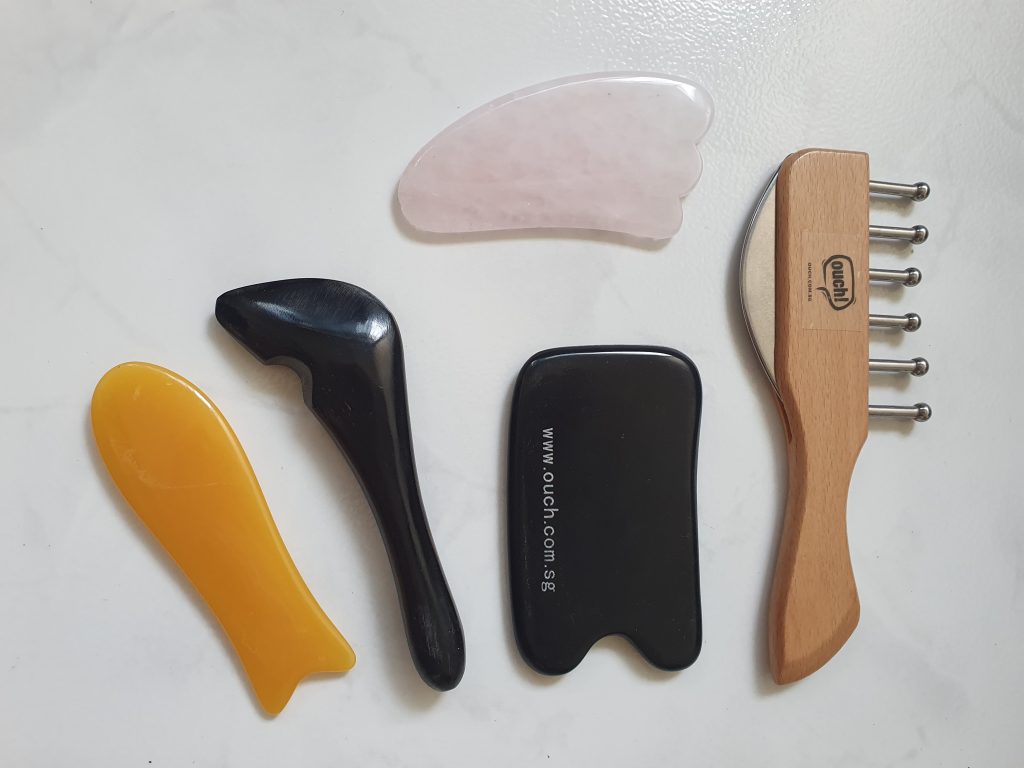Selecting Your Guasha Tool: A Guide to Finding the Right Fit
When it comes to guasha, choosing the right tool can make a big difference in your experience and results. With the variety of shapes, materials, and sizes available today, it’s natural to feel a bit overwhelmed—especially if you’re new to this practice. From porcelain spoons to specialized stone tools, your options are vast, and each material brings its own unique benefits. Here’s a closer look at different guasha tools and insights from my own journey with them.
Guasha Boards: Shapes, Sizes, and Materials
Guasha boards come in many forms, and it’s worth trying out different ones to find the best fit. Boards made from jade, rose quartz, buffalo horn, Bian stone, and stainless steel each provide a unique feel and set of qualities. For beginners, it might help to start with something you have at home; believe it or not, even a porcelain spoon can be used for guasha! The key to a good tool is a smooth surface to avoid causing unnecessary friction or injury to the skin.
My Journey with Guasha Boards
My exploration with guasha tools began with buffalo horn boards. I loved the firm grip they provided, and they were surprisingly resilient against wear and tear. Buffalo horn is known for its durability, but, admittedly, I sometimes found it hard to distinguish it from other materials that look similar.
When COVID arrived, I experimented with Bian stone guasha boards. These are special because Bian stone, a micro-crystalline stone, is rich in over 30 minerals and trace elements beneficial to our bodies. Bian stone has earned rave reviews for its therapeutic qualities, and my experience was positive in terms of comfort and effectiveness. However, I encountered a drawback: the material is delicate, and despite careful packing with bubble wrap, several boards broke when I shipped them for virtual workshops. This unexpected fragility meant additional expenses and delays as I had to replace damaged boards for my clients.
Realising the need for something sturdier, I transitioned to stainless steel guasha boards, which have since become my go-to. Stainless steel offers a solid grip, similar to buffalo horn, and I no longer worry about breakage, especially when mailing boards. The durability and ease of sterilisation have made stainless steel a practical, reliable choice for me and my clients alike.
Does Material Really Matter?
One of the most valuable insights I received was from my professor, who advised me not to get overly focused on the board’s material. While each material has unique attributes, he stressed that what’s most important is the smoothness of the surface. A good guasha board should glide over the skin without causing irritation or injury, allowing you to enjoy the benefits without discomfort.
Finding Your Ideal Guasha Tool
Selecting the right guasha tool comes down to balancing personal preference, purpose, and practical considerations:
- For Home or Travel Use: If you plan to take your guasha board with you, consider durability. Stainless steel or buffalo horn tools might be better options for on-the-go use, as they are less prone to breaking.
- Skin Sensitivity: Jade and rose quartz are cooling, which can be especially soothing if your skin tends to become red or irritated easily. Bian stone, known for its mineral content, is great for added therapeutic benefits if handled carefully.
- Ease of Use: For beginners, a smooth, easy-to-grip tool is essential. If you’re starting out, test different shapes to see which fits comfortably in your hand and feels right for your skin.

Remember, the best guasha board is the one you feel comfortable using and that suits your lifestyle. If you’re interested in incorporating guasha into your wellness routine, give a few different materials a try and see which resonates most with you.
